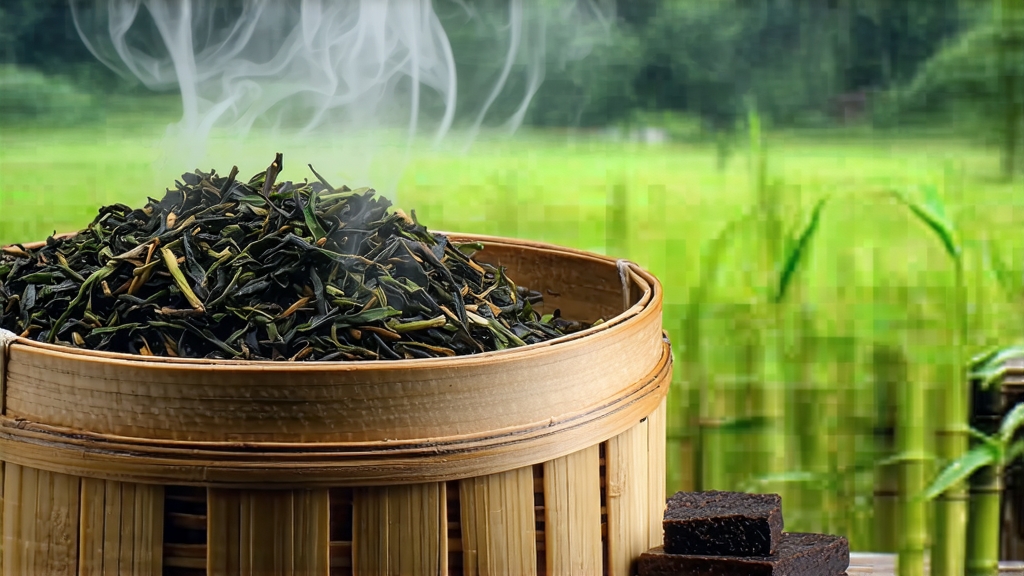
Tucked into the humid folds of southern China’s Guangxi Zhuang Autonomous Region, Liu Bao tea has spent the last four centuries quietly transforming itself from a frontier commodity into one of the most intriguing members of the dark-tea family. Unlike the better-known Pu-erh of Yunnan, Liu Bao never clamors for attention; instead, it seduces the drinker with a deep, mellow sweetness that recalls dried longan, damp forest floor, and the faint perfume of betel nut lingering on an old trader’s breath. To understand Liu Bao is to step into the humid storerooms of Wuzhou, where the air is thick with the scent of fermentation and the ticking of microbial clocks that measure years in weeks.
Historical footprints
The story begins in the small county of Cangwu, where the Liu Bao River once carried bamboo rafts loaded with tea to the trading port of Wuzhou. From there, compressed baskets of dark leaves sailed down the Xi Jiang system to Guangzhou and on to Hong Kong and Southeast Asia. In the 19th century, Liu Bao became the ballast tea of Chinese emigrants—cheap, sturdy, and capable of improving rather than spoiling during a three-month sea voyage. Dockworkers in Singapore and tin miners in Kuala Lumpur brewed it in enamel mugs, believing it chased away malaria and the chill of pre-dawn shifts. By the 1950s, Guangxi state tea factories were exporting Liu Bao to Hong Kong tea houses, where it was blended into “bo lei,” the Cantonese name for dark tea served with dim sum. Today, vintage baskets from the 1970s fetch eye-watering prices at auction, but the tea is still carried out of the mountains on the backs of mules, echoing the caravans of the Tea Horse Road.
Micro-terroirs within one name
Although “Liu Bao” is legally protected as a geographical indication, the tea is not the product of a single mountain but of a mosaic of micro-climates scattered across 15 townships. The core area lies between 200 and 800 m elevation, where lateritic soils, high humidity, and frequent fog create a natural greenhouse for the large-leaf Camellia sinensis var. sinensis indigenous to Guangxi. Garden managers speak of three stylistic bands: the river-valley teas that bake in reflected heat and develop cocoa-like depth; the mid-slope gardens where cooler nights preserve a floral high note; and the mist-locked summits whose slow-growing leaves yield a resinous, almost piney finish. Within these bands, cultivars such as “Xiao Ye Zhong” (small leaf) and “Ling Yun Bai Hao” (white downy) are prized for their ability to withstand the intense wet-pile fermentation that defines Liu Bao.
Crafting darkness: the double fermentation
Liu Bao’s identity is forged in two acts. The first is a conventional kill-green, rolling, and sun-drying that produces maocha not unlike a robust green tea. The second act, however, is a Guangxi invention known as “wo dui” (wet piling), predating the analogous process made famous by ripe Pu-erh by at least two decades. Workers build 1.5-meter heaps of maocha, spray them with river water, and cover them with jute sacks and banana leaves. Inside the pile, temperatures rise to 60 °C within 36 hours; thermophilic microbes—Bacillus, Aspergillus, and the yeast Blastobotrys—proliferate, breaking down cellulose and releasing amino acids that will later sweeten into longan and honey notes. Every three days the pile is turned, aerated, and re-moistened; after 10 to 25 cycles, depending on the target style, the tea is spread out to dry. A lighter fermentation (roughly 60 hours total) preserves a woody briskness favored by Cantonese tea houses, while a deep fermentation (200-plus hours) yields the glossy, almost obsidian leaves that Malaysian collectors label “black gold.” Once dried, the leaves are steamed and pressed into 40 kg bamboo baskets lined with wild taro leaves, whose natural waxes impart a subtle herbal tint. The baskets are then moved to humid underground warehouses where a slow, secondary fermentation continues for years, even decades.
Decoding the basket codes
International buyers often confront a cryptic tattoo of numbers and Chinese characters burned onto the basket rim. The first two digits usually indicate the factory code: 8 for the historic Wuzhou Tea Factory, 6 for the newer